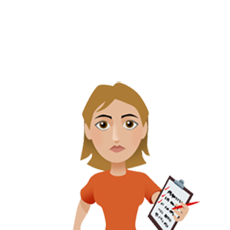6 Tools to Remember Your Grocery List (Or Anything Else)

Strengthening memory, for people with ADHD or other learning differences, can improve executive functioning and focus, as well as decrease frustration in the classroom, workplace, and at home.
While 21st century information overload definitely taxes our everyday memory, we have the ability to remember much more than we do. The key is to work at it. Not being able to remember what someone just said can result in the perception that you’re not paying attention to them; therefore, weakness in memory exacerbates the symptoms of ADHD.
Research shows that, with the right type of mental exercises, memory is one of the many cognitive skills that can be trained, strengthened, and enhanced. Nelson Dellis, a recent U.S. Memory Championship winner two years in a row, set a record by memorizing 248 random numbers in five minutes. Dellis says anybody can do it – with proper training. “Everybody who competes in these competitions trained their memory.”
According to Moonwalking with Einstein, a documentary chronicling Dellis’ one-year journey from “average” to USA Memory Champion, the average person wastes an estimated 40 days a year compensating for things he or she has forgotten. A better memory means less time searching for things, either physically or in your mind, and can lead to an improved understanding of academic material or instructions, better grades or work performance, and more opportunities.
Two Categories of Memory
Memory is broken into two main categories.
- Long-term memory stores information processed more than a few minutes ago.
- Short-term memory, often called working memory, is a type of mental scratch pad used to take in new information, hold it in awareness, work with it to complete another task, and then dismiss it.
One-on-one cognitive skills training can provide significant long-term or short-term memory changes. In addition, there are strategies that can improve any child or adult’s memory —right now. Practicing these memory techniques will make them easier and more effective, and will lead to a better, stronger memory.
Techniques to Improve Memory — NOW
Make memories memorable.
Many memory-building techniques rely on mnemonics, or learning techniques that use things that are easy to remember to represent things that are harder to remember. The human brain more easily recalls information that is personal and emotional, so assign strong multi-sensory associations to help remember things that are otherwise mundane.
For example, start with four items to remember a grocery list: bacon, toilet paper, eggs and lettuce. To link them in a memorable way, picture a sizzling strip of dancing bacon joyfully dripping hot grease onto the next item on your list – toilet paper. The animated toilet paper roll is in agony. It’s burned all the way through and is desperately trying to get patched up with egg whites. Stuck in the gooey mess of broken shells is an angry head of lettuce, trying to escape before her leaves wilt. If you can’t quite hold on to that image, build upon it with silly details until you can. Make the lettuce a Southern Belle with a nasal twang who is irate because her new French manicure is covered in egg yolks.
Use a Memory Palace
The memory palace is a powerful mnemonic technique that has been in use since ancient Rome and is routinely used by memory champions. It’s effective because it combines our remarkable ability to remember familiar places with other qualities that make memories memorable. With your own customizations, you can use this technique to remember long lists of almost anything. It’s great for outlining a speech or project and jogging your memory mid-stream.
The “palace” simply refers to any place you know well and can easily visualize a standard route through. Your house could easily be your memory palace. First, visualize the route in detail and mentally mark places where you will put memories. For example, you may go through your front door, then see your coat rack on the left, then see the staircase on the right, then pass the dining room table on your way to the kitchen. Once in the kitchen, you first see your refrigerator on the left.
Let’s use what to bring in the soccer bag as an example. Now, imagine taking the route again, and on each memory mark, visualize what you want to remember in vivid, ludicrous, and funny as possible detail. First, imagine the soccer ball crashing into the front door and leaving a muddy dent that will make your mother angry. Then, imagine your jersey tangled in the coat rack. At the dining room table, you may imagine shin guards on either side of the plates in the place of silverware, and the refrigerator could have arms coming out and handing you a gigantic bottle of cold water.
Article continues below...
Want to Motivate Kids?
Download a free tipsheet "The Parent's Guide to Motivating Your Complex Kid" to help your child find the motivation to do... anything and everything!
Sing it.
Creating a song is a fun way to remember many things. Remember “School House Rock?” If you’re the right age to have seen it every Saturday morning, you can still probably sing the Preamble to the Constitution. Assign the same type of song-style mnemonic to anything you want to remember. Easy tunes to use are “Twinkle, Twinkle, Little Star” or “Jingle Bells.”
Create your own acronyms.
Acronyms use parts of words to form another word that can be easier to remember. Creating your own acronyms is a great way to help your children remember daily chores or lists. For example, as they’re walking out the door for school, do a “SHLuB” check: Snack, Homework, Lunch and water Bottle. Eventually, your kids will start checking for “SHLub” themselves (or whatever acronym you choose). Have them help you come up with one – creating it will encourage greater buy-in.
Chunk it.
Chunking is the common practice of breaking large amounts of information into chunks the brain can handle. Studies show the average brain can hold about seven pieces of information before it gets overwhelmed. Social security, credit card, and telephone numbers are all chunked. Consider the number 7195508263. As a 10-digit number, it’s overwhelming. But when chunked into 719-550-8263, it’s easily recognized and much more efficient to memorize as a telephone number in Colorado.
Last but not least … take care of your brain.
Studies continue to show that healthy brain food, adequate sleep, physical and mental exercise, and social interaction all help boost memory. Deep breathing, adequate water intake, and proper supplies of vitamins and minerals are essential to proper brain function and memory.


